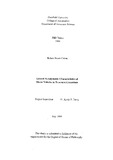JavaScript is disabled for your browser. Some features of this site may not work without it.
| dc.contributor.advisor | Garry, Kevin P. | |
| dc.contributor.author | Cairns, Robert Stuart | |
| dc.date.accessioned | 2008-04-22T10:55:31Z | |
| dc.date.available | 2008-04-22T10:55:31Z | |
| dc.date.issued | 1994-07 | |
| dc.identifier.uri | http://hdl.handle.net/1826/2507 | |
| dc.description.abstract | Motor car crosswind stability can be adversely affected by reductions in both vehicle mass and drag coefficient. As these are two likely results of future developments the importance of research into vehicle aerodynamic stability is set to increase, moreover, there is evidence that transient effects will be the critical. An experimental facility has been designed and constructed and tests have been carried out to investigate the implications of simulating dynamic flow-fields. Vehicle models of approximately 1/6th scale have been propelled along a test track, in the laboratory, to pass through a simulated crosswind gust of variable resultant yaw angle. Force and moment measurements have shown the aerodynamic inputs to be highly repeatable, though the technique has been restricted somewhat by the presence of mechanical "noise". Additional dynamic yaw experiments were conducted on a bluff-body model mounted in the College of Aeronautics' Oscillatory Facility. In some ways this technique is not as realistic as the Crosswind Track in its simulation of the full scale flow, however, despite its simplicity valuable aerodynamic data was derived from this test. Quasi-static tests have also been conducted and demonstrate that for certain model configurations a clearly defined yaw angle range exists where two different wake flow-structures are possible. At any given yaw angle, the dominant structure is determined by the flowfield history - essentially the direction in which the model is moved. This causes hysteresis in the forces and moments generated. In such a situation the flow is referred to as being bi¬stable. Both track and dynamic yaw tests indicate that the bi-stable flow phenomenon, witnessed in quasi-static experiments, can influence the dynamic forces and moments measured on a model. The flow structures associated with bi-stability are viscous-dominated and the slow development of viscous loads can be an important feature. It is possible that various vehicle configurations could induce bi-stable flow. If such flow behaviour is apparent then quasi-static forces and moment measurements will not provide an adequate engineering estimate of the transient aerodynamic loads. In this event it is imperative that the automotive engineer conducts investigations into the vehicle's dynamic performance. | en_UK |
| dc.language.iso | en | en_UK |
| dc.publisher | Cranfield University | en_UK |
| dc.rights | © Cranfield University 1994. All rights reserved. No part of this publication may be reproduced without the written permission of the copyright owner. | en_UK |
| dc.title | Lateral aerodynamic characteristics of motor vehicles in transient crosswinds | en_UK |
| dc.type | Thesis or dissertation | en_UK |
| dc.type.qualificationlevel | Doctoral | en_UK |
| dc.type.qualificationname | PhD | en_UK |
